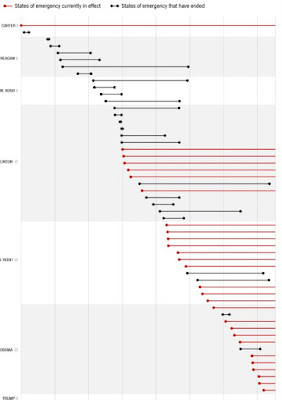Emergency provisions are too open ended. The old ones must be terminated to bring about the people's understanding of government actions.
Congress can terminate the status of these emergencies. End those completely which empower the USA military to war.
The President authorizes "States of Emergency" all the time when a state requests it after a hurricane, etc.
The Stafford Act (click here)
The federal government uses the Stafford Act of 1988 to respond to disasters that are less than national in scope but still call for federal relief. The act authorizes the Federal Emergency Management Agency (FEMA) to coordinate with and deliver aid to state or local governments overwhelmed by disasters or emergencies. It works according to a two-step process.
This is such nonsense by Trump. He is CAMPAIGNING on the people's tax dollars.
The Stafford Act (click here)
The federal government uses the Stafford Act of 1988 to respond to disasters that are less than national in scope but still call for federal relief. The act authorizes the Federal Emergency Management Agency (FEMA) to coordinate with and deliver aid to state or local governments overwhelmed by disasters or emergencies. It works according to a two-step process.
This is such nonsense by Trump. He is CAMPAIGNING on the people's tax dollars.
Immunity and Liability Issues (click here)
The national emergency provisions of the NEA do not address liability issues or provide any immunity. The act could be used to activate emergency authorities in other federal statutes that provide immunity during emergency events.
December 8, 2017
By Catherine Padhi
...All presidential authority (click here) is derived from either the Constitution or an act of Congress. As our Constitution contains no general emergency powers provision, presidents must look to Congressional acts for the authority to act beyond the normal limits of their powers. By 1973, Congress had enacted over 470 statutes granting the president special powers in times of crisis. These powers would lay dormant until the president declared a state of emergency, at which point all would become available for his use. And at the time, the president could declare an emergency as he alone saw fit: no procedures or rules constrained his discretion.
On Dec. 16, 1950, President Harry S. Truman declared a state of emergency in response to Korean hostilities. But the emergency didn't end with the war. By 1972, it was still in effect (and being used to wage war in Vietnam), so the U.S. Senate convened a special committee to investigate. The committee discovered three other active emergencies, each of which independently gave the president access to the entire set of emergency powers. According to the committee’s 1973 report, the crisis provisions together “confer[red] enough authority to rule the country without reference to normal constitutional process.”...
STATUTORY LEGISLATIVE PROCEDURES 1130(3) (click here) (also known as National Emergency Act)
of a joint resolution or bill to amend or repeal its provisions (P.L. 98–
119, Sept. 29, 1983, p. 26493). The 98th Congress provided for expedited consideration in the Senate of bills or joint resolutions requiring the removal of U.S. forces engaged in hostilities outside U.S. territory without a declaration of war (P.L. 98–164, 97 Stat. 1062). Those procedures appear in section 601(b) of the International Security Assistance and Arms Export Control Act of 1976 (P.L.
94–329; 90 Stat. 765). In the 102d and 107th Congresses the President was granted specific authority within the meaning of section 5(b) of the Act to use U.S. armed forces (P.L. 102–1; P.L. 107–40; P.L. 107–243).
As of January 2019, (click here) 58 national emergencies have been invoked since the Act was enacted in 1976, with 31 of them having been renewed annually and remaining in effect as far back as 1979. On 6 March 2014, U.S. President Barack Obama, invoked, inter alia, the National Emergencies Act, and signed an executive order that declared a national emergency and ordered sanctions, including travel bans and the freezing of U.S. asset, against not-yet-specified individuals, later to be determined by the Secretary of the Treasury (in consultation with the Secretary of State) who had "asserted governmental authority in the Crimean region without the authorization of the Government of Ukraine" and whose actions were found, inter alia, to "undermine democratic processes and institutions in Ukraine". Donald Trump has kept in place the states of emergency put in place by his predecessors.
